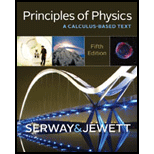
Concept explainers
A transverse sinusoidal wave on a string has a period T = 25.0 ms and travels in the negative x direction with a speed of 30.0 m/s. At t = 0, an element of the string at x = 0 has a transverse position of 2.00 cm and is traveling downward with a speed of 2.00 m/s. (a) What is the amplitude of the wave? (b) What is the initial phase angle? (c) What is the maximum transverse speed of an element of the string? (d) Write the wave function for the wave.
(a)
The amplitude of the wave.
Answer to Problem 14P
The amplitude of the wave is
Explanation of Solution
Write the expression for the general wave function.
Here,
Differentiate Equation (I) with respect to time to calculate the velocity.
Here,
Write the relation between the time period for the wave function.
Here,
Consider the trigonometric identity as below.
Conclusion:
Substitute
Substitute Equation (I) in Equation (II) for
Substitute
Substitute
Re-write the Equation (IV) by multiplying with common factors in numerator and denominators.
Substitute Equation (V) for
Substitute
Thus, the amplitude of the wave is
(b)
The initial phase angle of the wave.
Answer to Problem 14P
The initial phase angle of the wave is
Explanation of Solution
Obtain the expression to calculate the initial phase angle using Equations (V) and (VII).
Re-write the expression to determine the phase angle.
Conclusion:
Substitute
Since, the obtain value of tangent is negative, phase angle must lie in second or fourth quadrant. The value of sine is positive and the value of cosine is negative for the given wave function. This condition is possible only in second quadrant.
Then, calculate the phase angle in second quadrant.
Thus, the initial phase angle of the wave is
(c)
The maximum speed of the transverse speed spring element.
Answer to Problem 14P
The maximum speed of the transverse speed spring element is
Explanation of Solution
Write the expression to calculate the maximum transverse speed from equation (VII).
Here, the maximum transverse speed of spring element is
Conclusion:
Substitute
Thus, the maximum speed of the transverse speed spring element is
(d)
The wave function for the wave.
Answer to Problem 14P
The wave function for the wave is
Explanation of Solution
Write the expression for the speed of propagation of the wave in x direction.
Here,
Write the expression to calculate the wave number.
Conclusion:
Substitute
Substitute
Substitute
Thus, the wave function for the wave is
Want to see more full solutions like this?
Chapter 13 Solutions
Principles of Physics: A Calculus-Based Text
- Is work function of a metals surface related to surface energy and surface tension? What is the need to the work function component in the math of tension of metal surfaces that cannot be provided by existing equations of surface energy and surface tension? What are the key differences in each parameter and variables that allow for a differentiation of each function? What has a more significant meaning work function, surface tension or surface energy? Are there real differences and meaning? Please clarify and if possible provide examples . Does surface tension dependant on thickness of a metal or type of metal surface all having the same thickness? Clearly temperature has a profound change on surface tension what other variables besides temperature are key to surface tension. What if any is there a connection between crystal structure of the element and surface energy and tension? This is NOT a Assignment Question!!!arrow_forwardThe cylindrical beam of a 12.7-mW laser is 0.920 cm in diameter. What is the rms value of the electric field? V/marrow_forwardConsider a rubber rod that has been rubbed with fur to give the rod a net negative charge, and a glass rod that has been rubbed with silk to give it a net positive charge. After being charged by contact by the fur and silk...? a. Both rods have less mass b. the rubber rod has more mass and the glass rod has less mass c. both rods have more mass d. the masses of both rods are unchanged e. the rubber rod has less mass and the glass rod has mroe massarrow_forward
 Physics for Scientists and Engineers: Foundations...PhysicsISBN:9781133939146Author:Katz, Debora M.Publisher:Cengage Learning
Physics for Scientists and Engineers: Foundations...PhysicsISBN:9781133939146Author:Katz, Debora M.Publisher:Cengage Learning University Physics Volume 1PhysicsISBN:9781938168277Author:William Moebs, Samuel J. Ling, Jeff SannyPublisher:OpenStax - Rice University
University Physics Volume 1PhysicsISBN:9781938168277Author:William Moebs, Samuel J. Ling, Jeff SannyPublisher:OpenStax - Rice University Principles of Physics: A Calculus-Based TextPhysicsISBN:9781133104261Author:Raymond A. Serway, John W. JewettPublisher:Cengage Learning
Principles of Physics: A Calculus-Based TextPhysicsISBN:9781133104261Author:Raymond A. Serway, John W. JewettPublisher:Cengage Learning Physics for Scientists and Engineers, Technology ...PhysicsISBN:9781305116399Author:Raymond A. Serway, John W. JewettPublisher:Cengage Learning
Physics for Scientists and Engineers, Technology ...PhysicsISBN:9781305116399Author:Raymond A. Serway, John W. JewettPublisher:Cengage Learning Physics for Scientists and EngineersPhysicsISBN:9781337553278Author:Raymond A. Serway, John W. JewettPublisher:Cengage Learning
Physics for Scientists and EngineersPhysicsISBN:9781337553278Author:Raymond A. Serway, John W. JewettPublisher:Cengage Learning Physics for Scientists and Engineers with Modern ...PhysicsISBN:9781337553292Author:Raymond A. Serway, John W. JewettPublisher:Cengage Learning
Physics for Scientists and Engineers with Modern ...PhysicsISBN:9781337553292Author:Raymond A. Serway, John W. JewettPublisher:Cengage Learning





